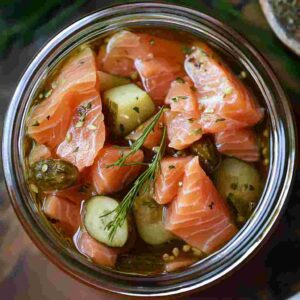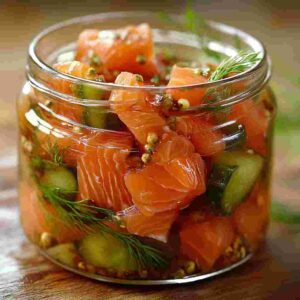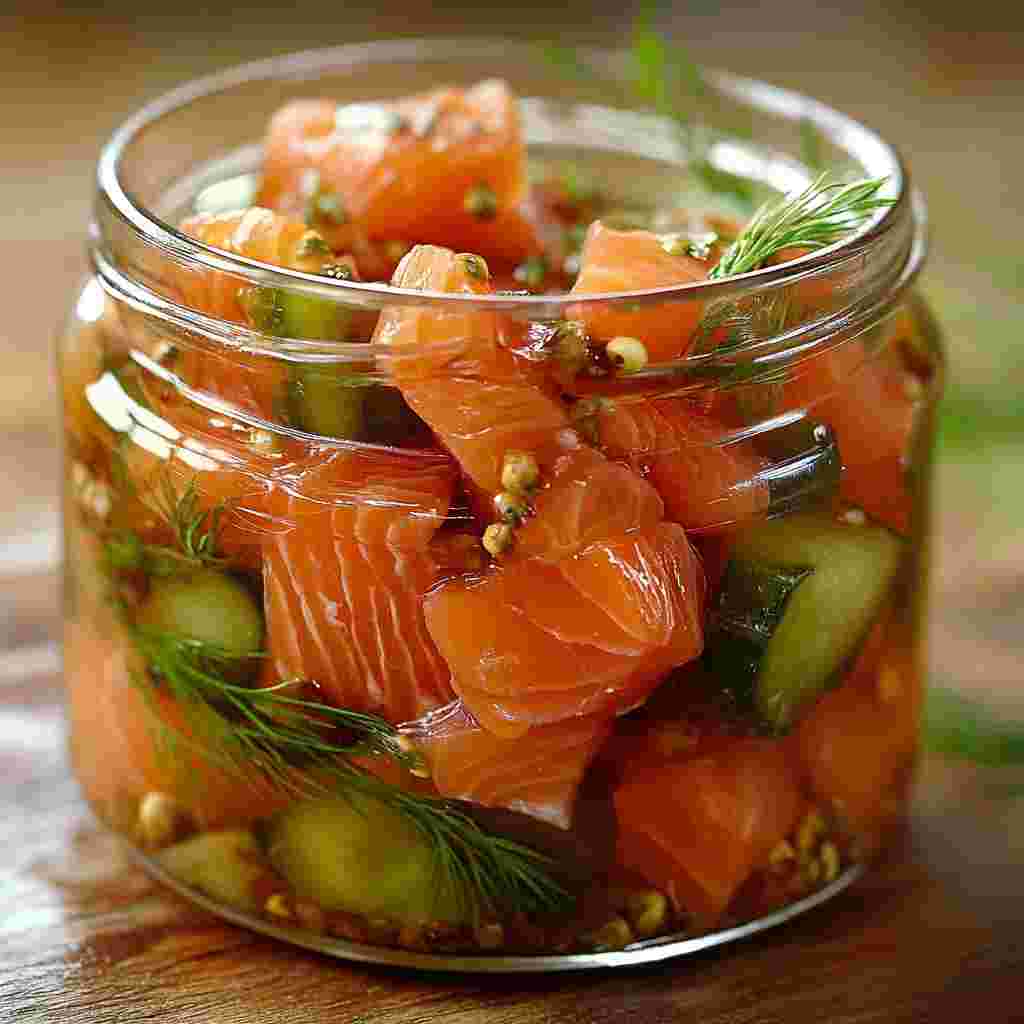Pickled salmon, also known as gravlax or cured salmon in some Scandinavian cuisines, is a delightful way to preserve salmon while infusing it with tangy, sweet, and savory flavors. By marinating fresh salmon in a mixture of vinegar, sugar, salt, and spices, you can transform it into a delicious dish that can be served as an appetizer, on sandwiches, or as part of a salad. This pickled salmon recipe is easy to follow and results in a flavorful, tender fish that can be enjoyed for several days after preparation.
For another preserved seafood option, try this Marinated Herring Recipe that offers a different take on traditional pickling.
Pickling salmon is a great way to highlight the natural flavors of the fish, and it’s also a popular method for extending the shelf life of fresh salmon. The combination of vinegar and spices gives the salmon a refreshing, tangy taste that pairs beautifully with a variety of side dishes.
Let’s dive into the step-by-step guide for making your own pickled salmon at home!

Ingredients Overview for Pickled Salmon
Here’s what you’ll need to prepare this delicious and tangy pickled salmon:
For the Salmon:
- Fresh salmon fillet – Skinless, boneless, and cut into thin slices or chunks.
- Coarse sea salt – Helps cure the fish and draws out moisture.
- Granulated sugar – Balances the salt and vinegar in the brine.
- White or red onion – Thinly sliced to add flavor and texture.
- Fresh dill (optional) – Adds a fragrant, herbal note to the pickling process.
For the Pickling Brine:
- White vinegar or apple cider vinegar – Provides the tangy base for the pickling process.
- Water – To dilute the vinegar and balance the brine.
- Bay leaves – For a subtle, earthy flavor.
- Whole black peppercorns – Adds mild heat and depth to the brine.
- Mustard seeds – A traditional pickling spice that adds a slight pungency.
- Allspice berries (optional) – Adds warmth and complexity.
- Cloves (optional) – For a hint of sweetness and spice.
- Lemon slices – Brightens the flavor with a fresh citrus note.
- Dill sprigs (optional) – Adds a subtle, herby aroma.
Step-by-Step Instructions for Pickled Salmon
1. Prepare the Salmon
Ingredients:
- 1 pound fresh salmon fillet, skinless and boneless
- 2 tablespoons coarse sea salt
- 2 tablespoons sugar
Instructions:
- Slice the salmon: Cut the salmon fillet into thin slices, about 1/4 inch thick. You can also cut the salmon into small bite-sized chunks if preferred.
- Cure the salmon: In a shallow dish, sprinkle the salmon slices evenly with the coarse sea salt and sugar, making sure to coat both sides of the fish. Let the salmon sit for about 20-30 minutes to draw out moisture and begin the curing process. This will help firm up the fish and enhance its flavor.
- Rinse and pat dry: After the curing time is complete, gently rinse the salmon under cold water to remove excess salt and sugar. Pat the fish dry with a paper towel and set aside.
2. Prepare the Pickling Brine
Ingredients for Pickled salmon recipe:
- 1 1/2 cups white vinegar or apple cider vinegar
- 1 1/2 cups water
- 1 tablespoon sugar
- 1/2 teaspoon salt
- 1/2 teaspoon mustard seeds
- 6-8 whole black peppercorns
- 2-3 bay leaves
- 4 allspice berries (optional)
- 2 cloves (optional)
- 1/2 white or red onion, thinly sliced
- Lemon slices (from 1 lemon)
- Fresh dill sprigs (optional)
Instructions:
- Make the brine: In a small saucepan, combine the vinegar, water, sugar, and salt. Stir well to dissolve the sugar and salt.
- Add spices: Add the mustard seeds, black peppercorns, bay leaves, and any additional spices (allspice, cloves) to the brine mixture. Bring the brine to a simmer over medium heat. Let it cook for 5-7 minutes to allow the spices to release their flavors. Explore the health benefits of common pickling spices
- Cool the brine: Remove the saucepan from heat and let the brine cool to room temperature. This step is important because you don’t want to pour hot brine over the salmon, which could cook the fish instead of curing it.
3. Assemble the Pickled Salmon
- Layer the ingredients: In a clean, airtight glass jar, layer the cured salmon slices with the sliced onions, lemon slices, and fresh dill sprigs (if using). Make sure the ingredients are evenly distributed throughout the jar.
- Pour the brine: Once the brine has cooled, pour it over the salmon, onions, and lemons in the jar. Ensure the salmon is fully submerged in the brine.
- Seal and refrigerate: Seal the jar tightly with a lid and place it in the refrigerator. Let the salmon pickle for at least 24 hours to allow the flavors to develop fully.
4. Serve the Pickled Salmon
- Taste and adjust seasoning: After 24 hours, your pickled salmon is ready to enjoy! Taste a piece and, if desired, adjust the seasoning by adding more vinegar or salt if needed.
- Serving suggestions: Pickled salmon is perfect as an appetizer or snack, served with crackers or rye bread. It can also be paired with cream cheese, capers, or fresh herbs. For a Scandinavian touch, serve it with boiled potatoes and a dill-mustard sauce.

Tips for Making the Best Pickled Salmon
1. Use Fresh, High-Quality Salmon
- Always use the freshest salmon you can find for pickling. Wild-caught salmon is often preferred for its richer flavor, but any high-quality salmon fillet will work. Ensure that the salmon is firm and bright in color with no off odors.
2. Cool the Brine Before Pouring
- Always allow the pickling brine to cool to room temperature before pouring it over the salmon. Hot brine can cook the salmon instead of curing it, which would change the texture and result in less tender fish.
3. Allow Enough Pickling Time
- While the salmon will start to absorb flavors within a few hours, it’s best to let it pickle for at least 24 hours for maximum flavor. You can leave it for up to 2-3 days for a stronger, more tangy taste.
For more seafood recipes, check out this Gravlax Recipe, another delicious cured salmon dish with Scandinavian roots.
Variations of Pickled Salmon Recipe
While this recipe offers a classic approach to pickled salmon, you can experiment with different flavors and ingredients to create a unique twist on this traditional dish:
1. Spicy Pickled Salmon
- Add a kick to your pickled salmon by incorporating sliced fresh chili peppers or red pepper flakes into the brine. Jalapeños, serrano peppers, or even a dash of cayenne pepper can add a spicy edge to the tangy brine.
2. Sweet and Tangy Pickled Salmon
- For a sweeter version, increase the sugar in the brine. You can also use honey or maple syrup for a more complex sweetness. This pairs particularly well with the natural richness of the salmon, giving it a sweet-sour balance.
3. Citrus-Infused Pickled Salmon
- Add additional citrus elements to the brine for a fresh, zesty flavor. In addition to lemon slices, try adding thin slices of orange or lime. The bright citrus flavors complement the tangy vinegar and enhance the delicate flavor of the salmon.
4. Herbed Pickled Salmon
- Elevate the flavors with a variety of fresh herbs. Aside from dill, you can add fresh thyme, tarragon, or rosemary to the brine. The herbal notes will infuse the salmon with a more complex, earthy taste.
5. Pickled Salmon with Ginger and Soy
- For an Asian-inspired variation, add sliced fresh ginger and a splash of soy sauce to the pickling brine. This adds an umami flavor that pairs beautifully with the delicate salmon, creating a unique fusion of flavors.
Nutritional Insights of Pickled Salmon
Pickled salmon is not only delicious but also offers several nutritional benefits. Here are some key highlights:
1. Rich in Omega-3 Fatty Acids
- Salmon is well-known for being rich in omega-3 fatty acids, which are essential for heart health, brain function, and reducing inflammation. Eating pickled salmon is a great way to enjoy these heart-healthy fats.
2. High in Protein
- Like all fish, salmon is an excellent source of high-quality protein. A serving of pickled salmon provides a substantial amount of protein, which is important for muscle repair and growth.
3. Low in Carbohydrates
- Pickled salmon is naturally low in carbohydrates, making it suitable for low-carb and keto diets. The sugar used in the pickling brine is minimal, but you can adjust it according to your dietary preferences.
4. Rich in Vitamins and Minerals
- Salmon is an excellent source of several essential vitamins and minerals, including vitamin D, B vitamins, and selenium. These nutrients help support bone health, energy production, and immune function.
For another seafood dish that’s packed with nutrients, try this Cured Salmon Gravlax Recipe, which offers a simple yet flavorful way to enjoy salmon.
How to Serve and Store Pickled Salmon
1. Serving Suggestions for Pickled Salmon
- Appetizer: Serve thin slices of pickled salmon on toasted bread or crackers with a dollop of sour cream, cream cheese, or crème fraîche. Garnish with capers, fresh dill, or red onion for an extra burst of flavor.
- Salad: Add pickled salmon to a light salad with mixed greens, cucumber, red onion, and a citrus vinaigrette for a refreshing meal.
- Smørrebrød: For a Scandinavian twist, serve pickled salmon on traditional rye bread, topped with hard-boiled eggs, dill, and thinly sliced cucumbers.
- Main Dish: Incorporate pickled salmon into a pasta or grain-based dish, such as quinoa or barley, for a hearty, flavorful meal.
- Breakfast: For a delicious breakfast option, serve pickled salmon with scrambled eggs or on a bagel with cream cheese, similar to lox. Discover the history and cultural significance of lox
2. Storing Pickled Salmon recipe
- Refrigeration: Store pickled salmon in an airtight jar or container in the refrigerator. Properly pickled salmon can last for up to 5 days in the fridge, as long as it’s fully submerged in the pickling brine. The longer it sits, the more intense the flavors will become.
- Freezing: While pickled salmon is typically enjoyed fresh, you can freeze it if needed. Place the salmon (without the brine) in a freezer-safe container or bag and freeze for up to 3 months. When ready to use, thaw the salmon in the refrigerator and pour fresh brine over it before serving.
For more ideas on how to store and serve seafood, try this Marinated Herring Recipe, another preserved fish delicacy with vibrant flavors.
Frequently Asked Questions (FAQs) About Pickled salmon recipe
1. Can I use frozen salmon for pickling?
- Yes, you can use frozen salmon for this recipe. Just make sure to thaw it thoroughly in the refrigerator before starting the pickling process. Frozen salmon can be just as effective as fresh salmon, especially if you’re concerned about availability or seasonality.
2. Is it safe to eat raw pickled salmon?
- The pickling process partially “cooks” the salmon through the acidic vinegar brine, making it safe to eat. However, it’s important to use fresh, high-quality salmon and to follow proper curing and refrigeration steps to ensure the fish is safe for consumption.
3. How long should I pickle the salmon?
- For the best flavor, allow the salmon to pickle for at least 24 hours. The salmon will continue to develop flavor over time, and it can be left to pickle for up to 3 days. After that, the texture and flavor may change, so it’s best to consume it within 5 days.
4. Can I reuse the brine for another batch of pickled salmon?
- It’s not recommended to reuse the brine for another batch of salmon because the acidity and seasoning may not be as effective the second time. Additionally, reused brine may not preserve the salmon properly, which could affect food safety.
5. What other types of fish can I pickle?
- In addition to salmon, you can pickle other types of fatty fish, such as mackerel, herring, or trout. The pickling process works well with oily fish, which absorbs the flavors of the brine while maintaining a firm texture.
Conclusion
This Pickled Salmon Recipe offers a delightful way to preserve fresh salmon while infusing it with tangy, sweet, and savory flavors. The pickling process is simple and creates a versatile dish that can be served as an appetizer, on a sandwich, or in a salad. Whether you’re enjoying it as part of a Scandinavian-inspired meal or as a refreshing seafood snack, pickled salmon is a unique and flavorful dish that’s sure to impress.
For more seafood preservation ideas, check out this Cured Salmon Gravlax Recipe, which offers another delicious cured salmon dish with Scandinavian roots.

